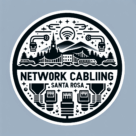What Type of Cable Is Used for Internet? A Complete Guide for Homes and Businesses
When setting up an internet connection, one of the most common questions people ask is: What type of cable is used for internet? Whether you’re connecting your home Wi-Fi, building a business network, or upgrading to faster speeds, the type of cable you choose makes a big difference in your internet’s performance and reliability.
Let’s break down the different types of cables used for internet connections, how they work, and which one is best for your needs. Our team of structured cabling experts in Santa Rosa helps homeowners and businesses choose the right cabling solutions for reliable internet performance.
Understanding How Internet Cables Work
Internet cables are the physical lines that transmit data between your modem, router, and connected devices. These cables carry signals in different ways — some through electrical impulses (like Ethernet), and others through light (like fiber optic cables).
Choosing the right type of cable affects:
- Speed: How fast your data transfers
- Signal quality: How stable your connection remains over long distances
- Compatibility: Whether it works with your equipment and network setup
1. Ethernet Cables (CAT5e, CAT6, CAT6a, CAT7)
Ethernet cables are the most common type of cable used for internet connections inside homes and offices. They connect your router or modem directly to your computer, smart TV, or other wired devices.
Here are the main types:
- CAT5e (Category 5e): Supports speeds up to 1 Gbps. Suitable for basic home internet.
- CAT6 (Category 6): Handles up to 10 Gbps at shorter distances. Great for gaming and streaming.
- CAT6a (Augmented CAT6): Designed for higher performance and better shielding against interference.
- CAT7: Offers even more protection and can reach up to 10 Gbps over longer distances.
Best for: Homes, offices, and businesses needing reliable wired connections.
2. Fiber Optic Cables
Fiber optic cables use strands of glass or plastic to transmit data as light signals, which means they deliver extremely high-speed internet with minimal signal loss — even over long distances.
There are two main types of fiber optic cables:
- Single-mode fiber (SMF): Used for long-distance, high-speed connections (common in ISPs and data centers).
- Multi-mode fiber (MMF): Used for shorter distances, such as in buildings or local networks.
Fiber internet is becoming more widely available across California and other states because of its superior speed and reliability.
Best for: Businesses, data centers, and homes with fiber internet service.
3. Coaxial Cables
Coaxial cables (or coax cables) are typically used by cable internet providers. They’re made with a copper core, insulation, and a metal shield that reduces interference.
While not as fast as fiber, coax cables can still deliver high-speed internet and are common in homes with cable TV or bundled services.
Best for: Residential areas with cable internet providers like Spectrum or Xfinity. If speed is your top priority, you’ll want to know what the fastest network cable is for your setup.
4. Telephone Cables (DSL)
DSL (Digital Subscriber Line) internet uses traditional telephone cables — twisted copper wires — to deliver internet. It’s much slower than fiber or Ethernet and is gradually being phased out as faster technologies expand.
However, in rural areas or smaller towns, DSL remains one of the few options available.
Best for: Rural homes without access to cable or fiber internet.
5. Satellite and Wireless Cables
Although not a “cable” in the traditional sense, some internet setups use satellite or fixed wireless technology. These systems require cables to connect antennas, routers, and power supplies.
Best for: Remote areas without wired internet infrastructure.
Which Internet Cable Is Right for You?
Here’s a quick comparison to help you decide:
| Cable Type | Speed | Distance | Ideal Use |
|---|---|---|---|
| CAT5e / CAT6 | Up to 1–10 Gbps | Short to medium | Homes, offices |
| Fiber Optic | Up to 100+ Gbps | Long | Businesses, data centers |
| Coaxial | Up to 1 Gbps | Medium | Homes with cable ISPs |
| DSL | Up to 100 Mbps | Short | Rural areas |
If you want the fastest and most reliable internet, fiber optic or CAT6 cabling is your best choice.
Why Professional Installation Matters
Even the best cable won’t perform well if it’s not installed correctly. Professional network cabling installers can ensure proper routing, termination, and testing, helping you avoid signal loss and interference.
Experts also make sure your setup meets local building codes, especially in California where regulations for low-voltage wiring and fire safety apply.
Future-Proof Your Internet Connection
Technology is always evolving — and your network should be ready for what’s next. Upgrading to CAT6a or fiber optic cabling helps future-proof your property for faster internet speeds and smart devices.
Whether you’re building a new office in Los Angeles or upgrading your home in San Francisco, investing in quality cabling ensures long-term reliability and performance.
Final Thoughts
When it comes to choosing what type of cable is used for internet, the best option depends on your location, speed requirements, and budget.
- For most homes, CAT6 or coaxial cables will do the job.
- For top performance, fiber optic is the gold standard.
- And if you’re in a rural area, DSL or satellite might still be the best available choice.
No matter which you choose, professional installation ensures you get the fastest, most stable connection possible. For a step-by-step guide to proper setup, check out our resource on how to do network cabling.
Contact your local network cabling experts in California today to find the best internet cabling solution for your home or business.
